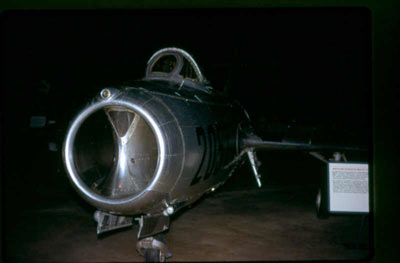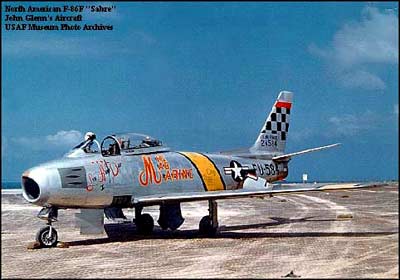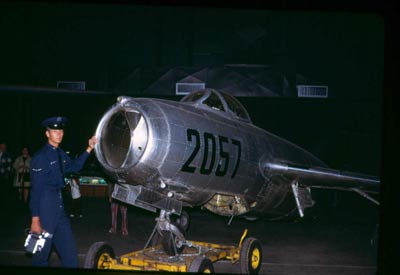| PERFORMANCE
OF THE MIG-15 IN AERIAL COMBAT |
|
|
|
When June 25, 1950 rolled around our Air Force and
that of the enemy was pretty antiquated. Yes, we had the P-51, a
few B-26s, and our basic jet was the F-80. The enemy relied mostly
on Yak-9s and a few TU-2s. The war required conventional equipment,
but little did we know of the rapid escalation which was about to
happen. Most of the action was on the ground, with ROK troops not
equal to the task of repelling the invaders. Our B-29s, from the
19th, 22nd, 92nd, 98th, and 307th had almost free reign over the
skies as they bombed Wonson, chemical factories, Pyongyang, and
most any target without concern of loss. The first missions flown
by the 91st SRS to obtain the all important photo coverage of prospective
targets which included airfields and Yalu bridges were mostly unopposed.They
accomplished their mission and all usually returned safely.The Yak-9
certainly posed no threat, and anti-aircraft fire was not yet radar
controlled. This condition was not to last very long.
| Soon there were rumors
of a new aircraft about to enter the battle. The 91st flew |

This Mig was stolen by North Korean pilot
NO KUM-SOK and flown to South Korea for a $100,000 reward.
Click
here for a larger view of image. |
|
|
across
the Yalu and photographed the airfield at Antung, which revealed
several hundred swept wing Mig-15s.So the rumors were correct.
Russia had supplied hundreds of the Migs to North Korea.
Besides the sightings at Antung, there were hundreds
more sitting on airfields in Manchuria. |
|
|
|
| THE MIKOYAN-GUREVICH MIG-15
FAGOT |
|
| The Mig-15 was developed by the
Soviet Union and appeared in service in 1949.It had a wingspan
of 33ft. 1in. Maximum weight was a little over 11,000 pounds.
Armament was by far the most impressive thing about this jet.It
carried three cannons, two 23 millimeter and one 37millimeter,
plus rockets or 2,000 pounds |
| of bombs. The
engine was highly reliable and was the aircrafts most
essential component. The British government authorized
the Rolls Royce company to export their Nene Turbojet
engine to Russia.The Russian Klimov design bureau immediately
built a copy of the Nene, called the Klimov RD-45. This
engine utilized a centrifugal compressor which worked
quite well with the design of the Mig. |
|
Maximum speed of this small but formidable jet was
670 MPH at sea level. Over 8000 were built in Russia, with thousands
more built in Poland and Czechoslovakia. Later in the year an improved
Mig-15bis version made it’s appearance. Performance and maneuverability
were impressive. It could outclimb our F-86 due to the higher angle
of attack capability. The main advantage it had over the F-86 was
the ability to climb to 51,000 ft. The F-86 had a reduced |

Click
here for a larger view of image.
|
capability above 30,000 ft.
The F-86 had all the comforts of home
that the Mig did not have. It had air conditioning and heat,
and the pilot wore a G-suit which helped control blood flow
at high maneuvering rates. Many argued that our planes were
out gunned by the Russians. Our aircraft used machine guns while
the Russians were equipped with cannons. |
|
|
| Toward the end
of the war our F-86F was equipped with 20 Millimeter cannons
and packed 600 pounds more thrust from their modified engine.
The F-86 also had a Sperry A-1C gunsight which utilized a range
limiter, not available on earlier models, resulting in more
accurate fire. I visited the Air Force Museum in Dayton on numerous
occasions. The F-86 was placed very close to the Mig-15. It
is my opinion that the overall workmanship of the F-86 was far
superior to the Mig. I have always been impressed with the quality
of our warplanes. Take a look at the P-51, P-38, B-29, etc.
|
|
|



